If you’ve been running Meta campaigns for a while, you’ve probably noticed a small but impactful update in how the platform talks about optimization.
Meta has reintroduced one of its most useful tools, value rules—and it’s no longer just a niche feature for e-commerce. This feature, once called conversion value rules, has evolved into something much more powerful.
Value rules let you tell the system that certain customer segments are more valuable than others, giving you more control over how Meta optimizes and allocates your budget.
It bridges the gap between automation and human insight, allowing you to “train” Meta’s AI to favor the audiences, locations, or devices that matter most.
In this guide, we’ll break down how value rules work, what’s new this year, and how you can use them to guide Meta’s delivery system toward quality, not just quantity.
Key takeaways:
- Meta value rules are no longer limited to e-commerce. They now cover all campaign goals, such as awareness, traffic, leads, and engagement.
- You can now create up to 6 different rule sets within the same account, as well as test seasonal, regional, and strategy-based bid adjustments.
- To analyze whether high-value segments truly drive higher ROAS and LTV, you can track the ad’s performance in Ads Manager’s Breakdown and validate with tools like Google Analytics or your CRM.
- Automation platforms make it simpler to build workflows that connect insights with real-time optimization across campaigns.
- Bïrch automates what Meta value rules start, helping you control ads automatically when performance changes.
What are Meta value rules, and why do they matter?
Originally launched as conversion value rules for e-commerce purchase events, the feature was renamed value rules in 2025 to reflect its broader use across all campaign types and objectives—from awareness and engagement to lead generation and sales.
Value rules let you adjust how much Meta’s algorithm values specific audience segments, based on the return they bring for your business.
In other words, instead of optimizing for the lowest-cost conversions, you can use value rules to tell Meta which conversions are most valuable to you based on audience, placement, and conversion criteria.
According to Investing, in 2022, Facebook ads reached 34.1% of the global population aged 13+. That’s about 2.11 billion people. Such massive reach is powerful, but it also means advertisers risk spreading budgets thin. Value rules help you spend where it actually matters: on high-value, high-intent users.

You can assign positive or negative adjustments for these criteria, so your budget focuses on the audiences that are most likely to deliver stronger, long-term results.
Let’s say you own an online clothing store, and you’re running ads to drive traffic. Meta will automatically optimize for the cheapest purchases, even though your insights tell you that women aged 25–34 tend to spend more and are more likely to become regular clients.
With value rules, you’re telling Meta, “Bid more for that audience.” It’s up to you how much more you can increase the bid. For example, you can set the bid to be +20% for women in that age group, and even decrease the bids for audiences who tend to browse without buying.
The logic is simple: instead of treating all conversions equally, you have the power to weight them based on quality.
Why value rules are essential for optimizing conversions and lifetime value
Not all conversions are of equal value. Some customers buy once and disappear, while others return, subscribe, or spend more over time. Value rules tell Meta’s algorithm which actions and users are truly worth investing in.
Instead of spreading budget evenly across lower-value audiences, you can drive more conversions from people with high intent. This improves ROAS and LTV, two of the most important metrics for long-term profitability.
For example, if data shows that leads from Germany convert at a higher rate, value rules let you bid more for those users by choosing that location.
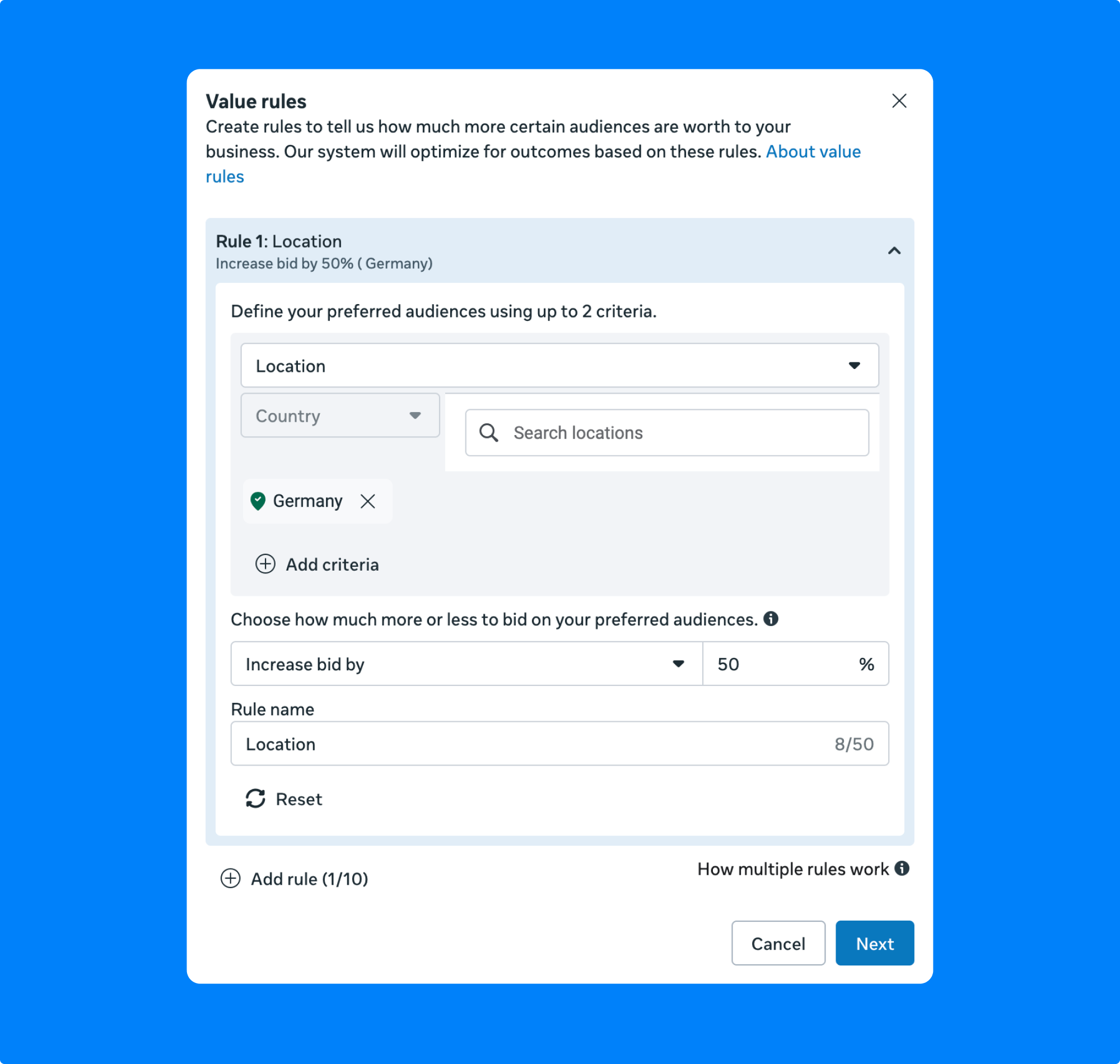
Applying the same logic, if engagement from certain places (like Instagram stories) generates better downstream sales than others (like Facebook stories), you know you should prioritize spend there.
How Meta’s AI uses value rules for smarter delivery
Meta’s ad delivery system is built around ad auctions and machine learning. It constantly analyzes audience behavior, conversion data, and creative performance to decide where spend will have the most impact.
Value rules now take smart delivery further.
When you define a rule, Meta’s AI still handles real-time optimization. The difference is that it now considers your chosen “value priorities” in its decision-making process. So instead of treating every conversion equally and choosing the users who see your ads, Meta now uses your set rules to adjust bid intensity within the auction, prioritizing impressions that are likely to drive better results.
In short, you provide the logic, and Meta applies it at scale.
Over time, this creates a learning loop. The system learns which audiences are worth more, and your value rules help it act on that insight instantly.
What’s new in 2025: expanded features and availability
2025 marks the biggest update yet to Meta’s value rules since their initial release. Here’s what’s new:
1. Value rules across all objectives
Once limited to “sales” and “app promotion” objectives, value rules are now available for all major objectives. This means you can assign value adjustments throughout the entire customer journey, not just at the bottom of the funnel.
2. Multiple rule sets (up to six per account)
You can now create and manage up to six different rule sets per account. This allows you to:
- Manage multiple business lines within a single ad account
- Test different bid adjustment strategies (+10%, +20%, etc.) to see which one works best for you
- Experiment with seasonal versus evergreen rule sets at the same time, without them interfering with one another

3. Location-level value expression: city-specific bidding
You can assign city-level adjustments if you see strong performance variations by market, increasing or decreasing your ad bids for specific cities.
4. Placement-level value rules (feed, reels, stories, audience network)
Meta has extended value rules to work at the placement level, meaning you can set unique bid adjustments for specific placements across Facebook and Instagram feed, reels, stories, and audience network.
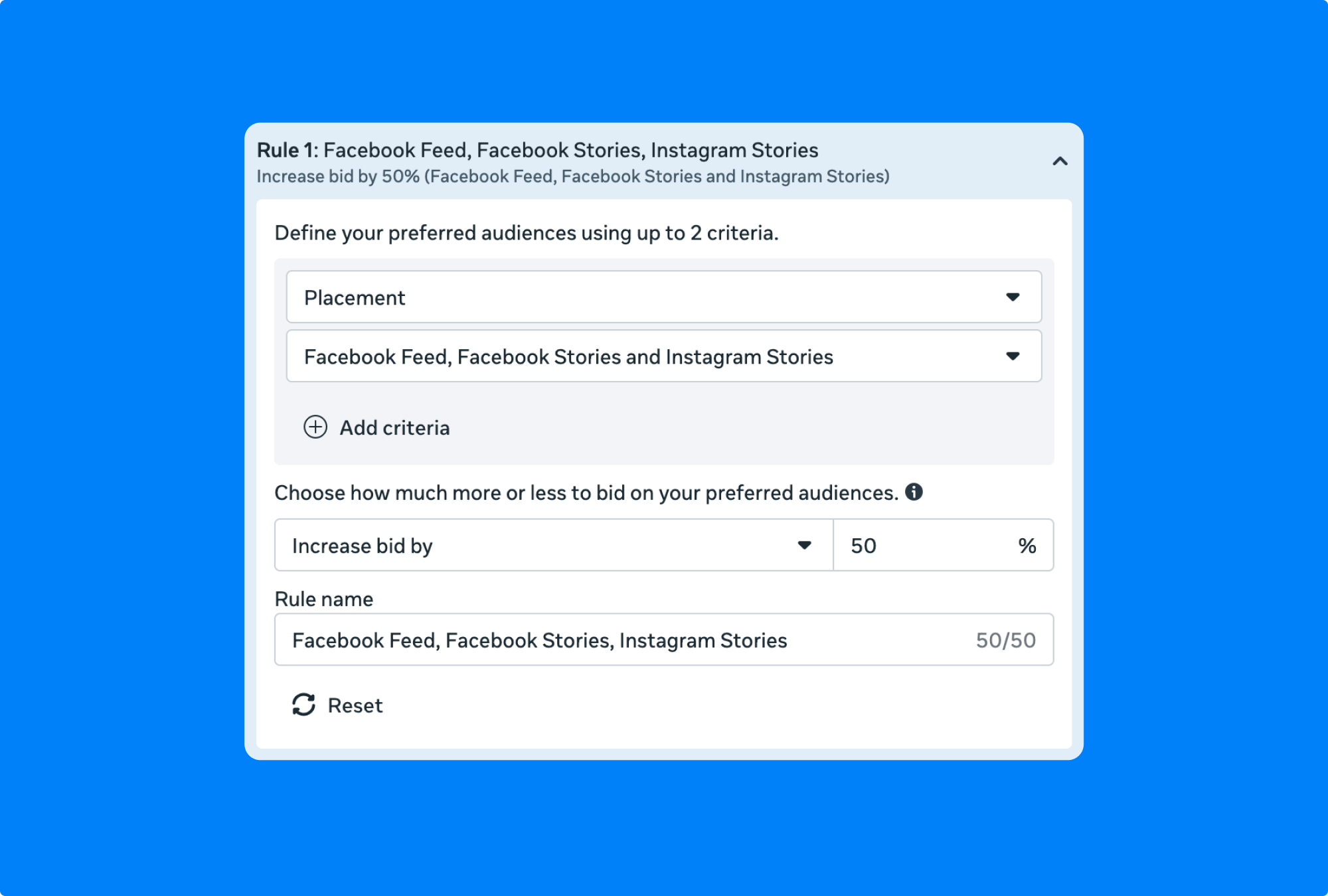
5. Attaching and detaching rule sets mid-flight without resetting learning
A game-changer for 2025 is the ability to attach or detach value rule sets while campaigns are live, without resetting the learning phase. This means you can update priorities, swap seasonal strategies, or test new multipliers in real time, all without disrupting performance optimization.
6. Marketing API access and advanced integrations
For larger teams and automation rules, Value Rules are now available through the Marketing API, allowing direct integration with third-party tools for real-time monitoring and performance automation.
7. Key differences between value rules and bid multipliers
While both tools modify bid behavior, bid multipliers only decrease bids and have no reporting layer.
Value rules allow increases and decreases, include built-in reporting breakdowns, and are accessible directly from Ads Manager.
Strategic use cases: maximizing customer lifetime value with value rules
Value rules let you align Meta’s delivery system with your business’s long-term goals. Using them strategically helps you prioritize audiences that bring the most revenue.
The link between value rules and long-term profitability
Meta’s AI naturally optimizes for volume: more conversions, installs, and engagement. You can redirect spend toward high-LTV segments—the customers who keep buying, subscribing, or referring others—by layering multiple value rules across audience, location, and device.
Let’s look at Aerie as an example. The women’s lifestyle brand identified 50 designated market areas where brand awareness was low. They used value rules to give them a boost by increasing bidding.

The results speak for themselves:
- 4.9-point lift in ad recall
- 5.6-point lift in brand favorability
- 22% lower cost per ad recall lift
- 33% lower cost per brand favorability lift
- 72% higher reached recall
By strategically raising bids in markets with strong growth potential, Aerie has invested in audiences who are more likely to convert and stay loyal over time. The approach helps build brand equity in high-value regions, translating into stronger long-term profitability through repeat purchases and sustained customer relationships.
Identifying and prioritizing high-value customer segments
Before creating any value rules, check which customer groups drive the highest revenue or engagement.
Notice patterns in:
- Demographics (age, gender, city/country)
- Device type or OS (Android versus IOS)
- Engagement source (reels, story, feed)
- Behavioral data (repeat purchases, subscription renewals, website revisits, etc.)
Build your value rules around these insights—for example, “+30% for top-tier markets, −20% for regions with low purchase completion rates.”
We spoke with Baruch Labunski, CEO at Rank Secure, who shared how he uses value rules to prioritize long-term value.
Applying LTV data to guide bid adjustments
You can turn LTV data into bidding logic with Meta value rules. Here’s how:
- Use higher bid multipliers for audiences that historically deliver higher LTV.
- Combine this with custom conversions (like “repeat buyer”) to guide AI toward better-quality conversions.
- Adjust seasonally—for example, increase bids in months when returning customers spike.
When I make the decision to increase or decrease my bids, I value the data around customer value over time. If an audience has been high-value, highly loyal, and high-retention over time, I would be more comfortable increasing my bid, even if the cost of the lead initially seems high. On the other end, if the leads are cheap but won’t close, we will likely spend less on them and most likely stop sending leads after a short time.
How to set up your first Meta value rule (step-by-step)
Setting up value rules in Meta Ads Manager is simple once you define who your most valuable customers are and how much more you’re willing to bid for them.
Step 1: check prerequisites
Before creating your first rule, make sure you:
- Have conversion tracking properly set up in Meta Ads Manager (via pixel, API, or SDK).
- Set a campaign objective that supports value rules (sales, leads, app promotion, awareness, traffic, or engagement).
- Have a Business Account with admin access.
Step 2: go to advertising settings
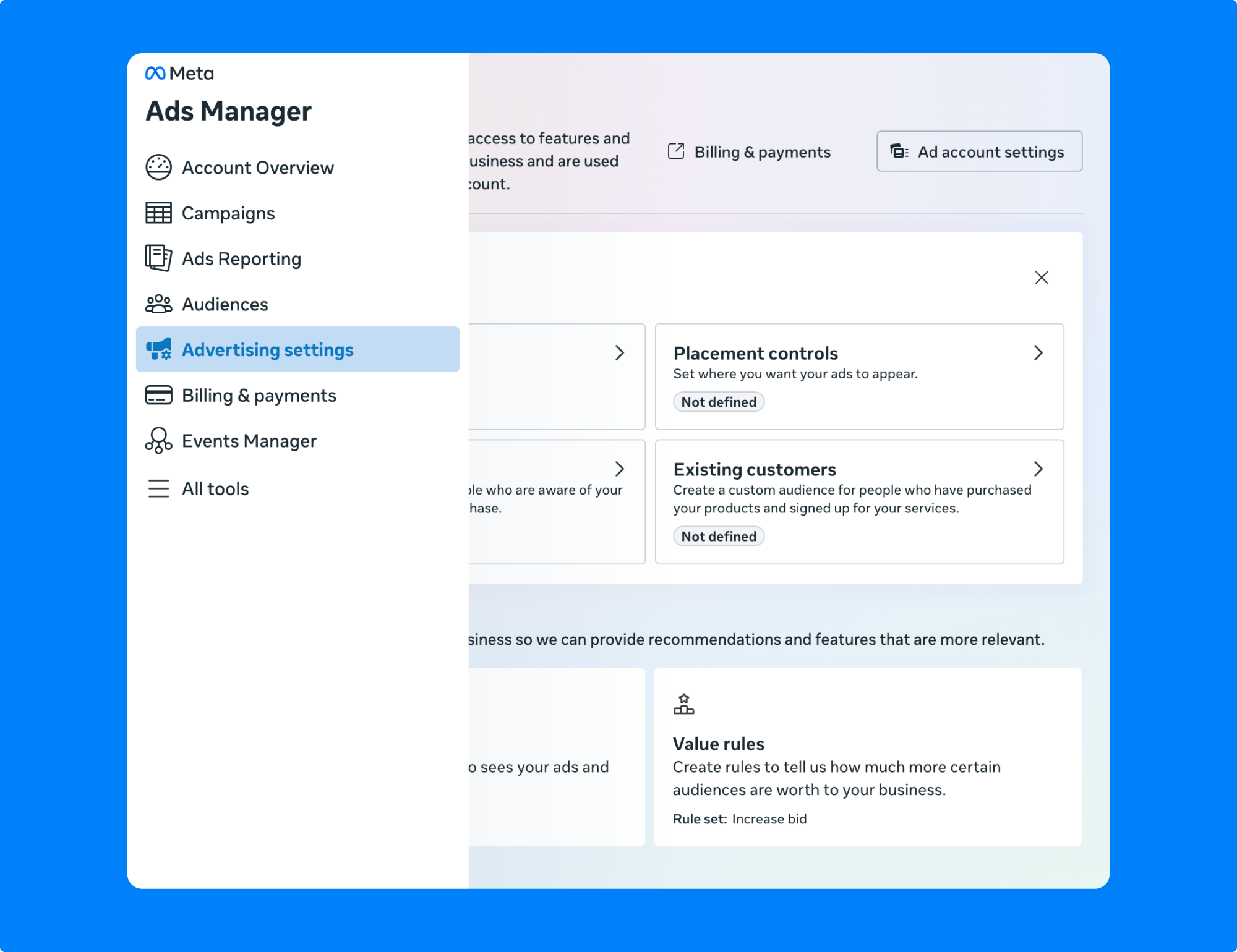
Open Meta Ads Manager → advertising settings → value rules (you’ll find it near the top section of your business settings).

Click value rules, and it will take you to another tab where you can create up to six rule sets per account.
Step 3: define your preferred audience
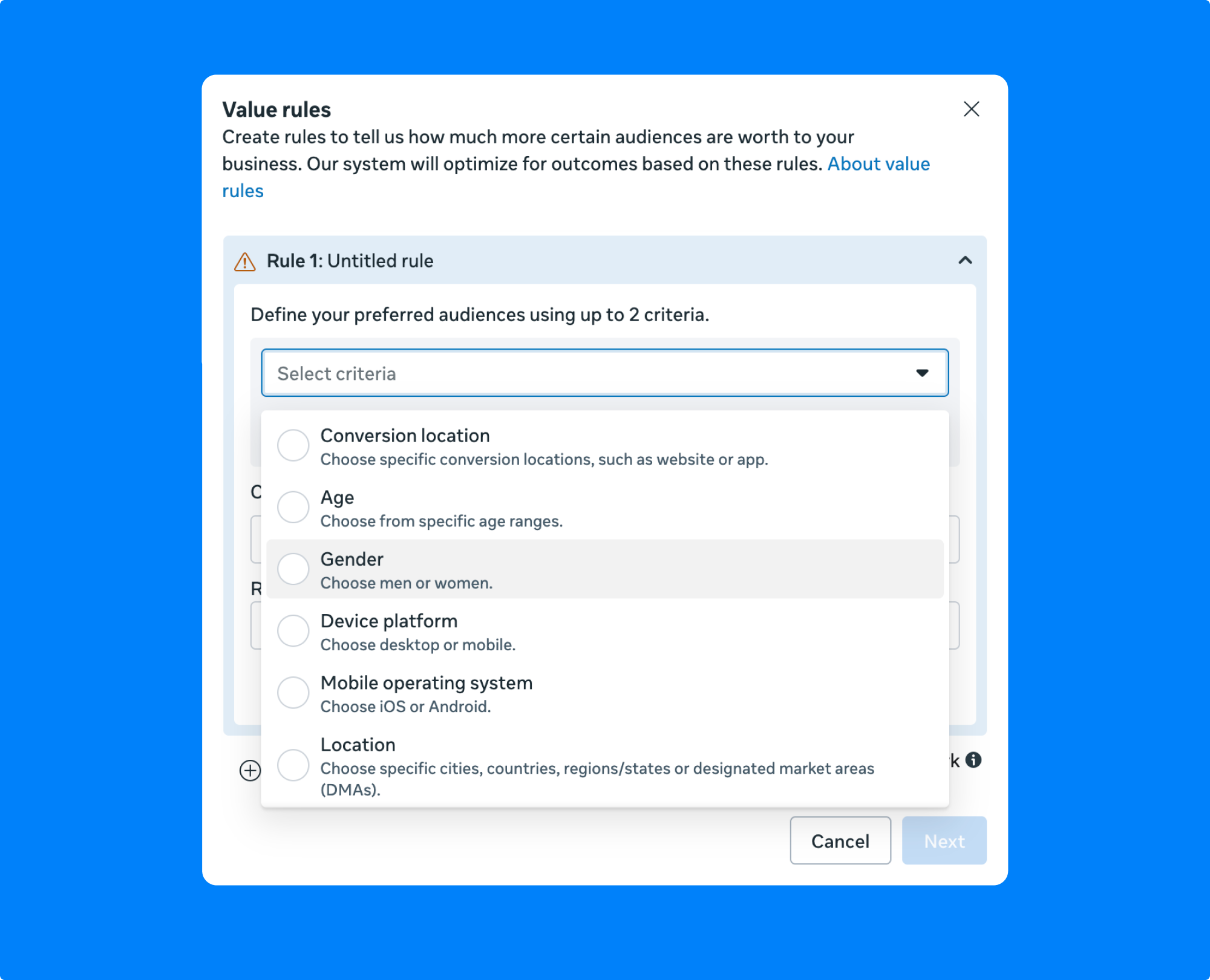
Choose up to two conditions that describe your high- or low-value audience. You can use parameters such as age, gender, location, and device.
For example: “Increase bid by 50% for women aged 25–34.”

Step 4: set bid adjustments
Next, decide how you want to modify your bid:
- Increase bids (up to +1,000%) to capture high-value audiences.
- Decrease bids (up to −90%) to reduce spend on lower-value segments.
Step 5: prioritize rules within a set
For audiences that meet multiple rule conditions, Meta prioritizes rules, selecting only the first matching rule in the list. For this reason, be sure to prioritize rules based on their relevance to your goals.
Step 6: apply and monitor
Once your rule set is ready, you can attach it to eligible campaigns during setup. Simply choose “use value rules” under your campaign’s performance goal.
From there, monitor results in Ads Manager → Breakdowns → value rules. You’ll see how each role influences outcomes like conversions, cost per result, and ROAS.
Integrating value rules with Advantage+ shopping campaigns
If you’re running Advantage+ sales campaigns or Advantage+ app campaigns, you can now layer value rules without disrupting Meta’s machine learning. The system keeps optimizing for conversions while incorporating your bid logic in real time.
Advanced optimization tactics
Placement-specific bidding: feeds vs stories vs reels
Placement impacts performance, and value rules now let you reflect that directly in your bidding strategy.
If Instagram Reels perform stronger than Facebook Stories, you can apply a positive adjustment to Reels and reduce bids to Stories without having to create a new campaign.
Device-level adjustments: mobile vs desktop optimization
Performance may vary by device type. With value rules, you can bid higher for users based on the mobile operating system, IOS or Android, depending on where you see better conversion rates or purchase behavior.
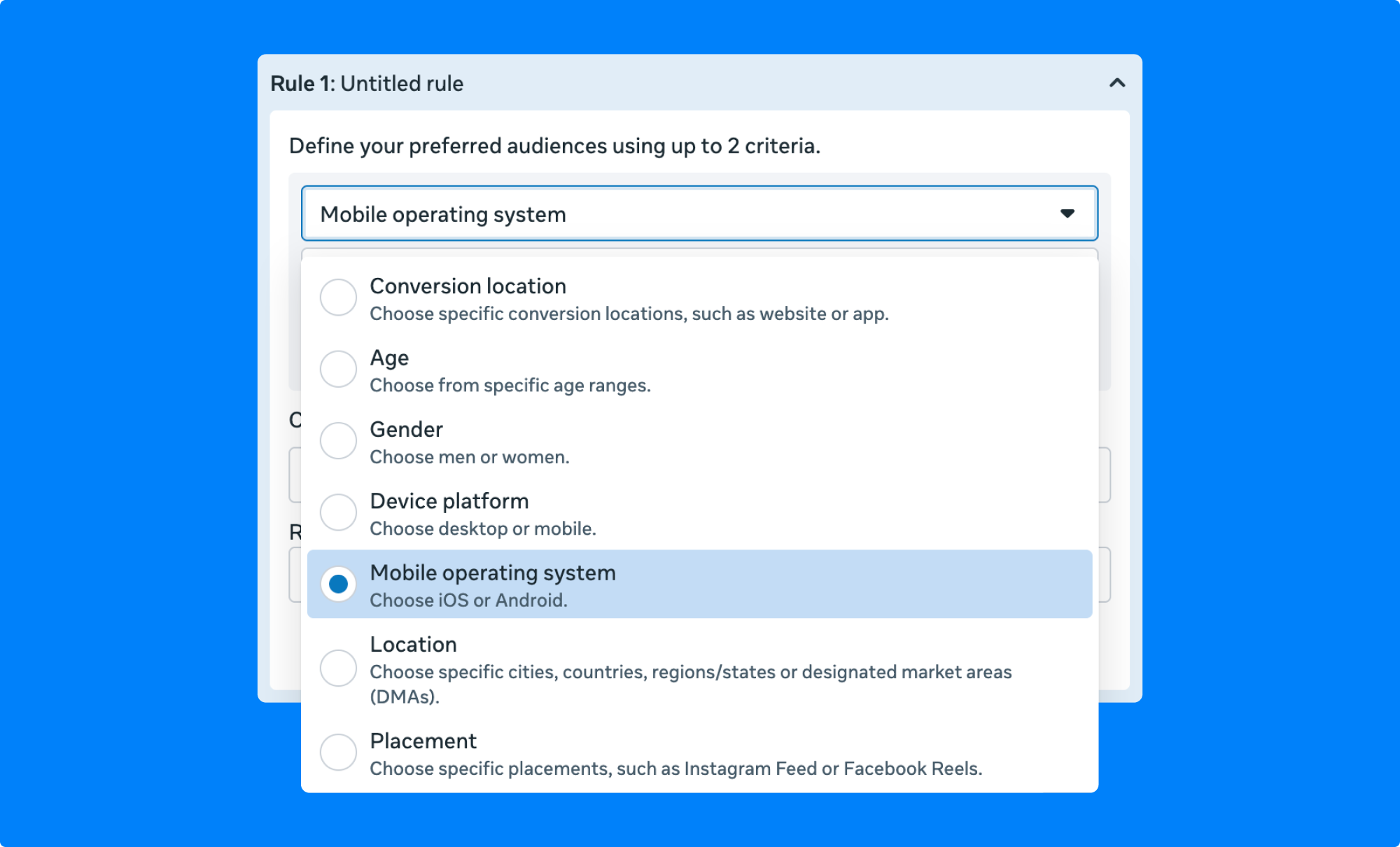
Geo-targeting with value rules: regional and city-level differences
Not all markets deliver equal results, and Meta lets you reflect those differences precisely in your optimization. You can set higher bids for high-performing cities or regions, and reduce bids where ROI is weaker.
This is also useful when you want to run seasonal campaigns—for example, by increasing bids in tourist-heavy areas during peak travel months and reducing spend where demand drops.
Improving lead quality in sales and lead generation campaigns
For lead generation campaigns, Meta value rules are a powerful way to filter out low-quality leads before they consume your budget.
For example, you can lower bids for users below a certain age range or outside target locations. Or, you can increase bids for devices or placements that historically bring higher conversion-to-sales ratios.
Dynamic segmentation: adapting rules to evolving customer behavior
Consumer behavior changes fast, and Meta’s AI learns continuously. You can constantly revisit and adjust your value rules based on real performance data.
If a placement that once underperformed suddenly starts driving conversions, you can always update your bid logic instead of removing it. Likewise, you can reduce bids for segments showing fatigue or rising CPAs.
Measuring and proving success
Setting up value rules is just the start. The real impact comes from tracking how they influence campaign performance over time.
Key metrics to track, and questions to ask
When value rules are active, monitor metrics that show both short- and long-term impact, including:
- ROAS: Are higher-value segments generating more revenue per dollar spent?
- CPA: Is your cost rising but delivering better-quality conversions?
- LTV: Are your campaigns capturing customers who spend or engage more over time?
- CTR and conversion rate: Are optimized segments producing stronger engagement signals?
You can use Bïrch to translate value rule logic into real-time actions (pause, scale, rotate) whenever KPIs cross a threshold, without having to monitor everything manually.

Conversion tracking and reporting in Meta Ads Manager
Analyze value rules directly in Ads Manager using the breakdown menu:
- Ads Manager → columns → customize columns → value rules to see performance per rule
- The breakdown → value rule set options let you view conversions, CPA, and ROAS by rule category (e.g., age, device, region)
Compare results over different time ranges to identify consistency, and see whether you need to adjust the bid.
Attribution modeling: understanding how value rules impact the funnel
Value rules influence where Meta’s AI spends money, not necessarily who converts first.
- To isolate the impact, use attribution breakdowns to compare results before and after activating value rules.
- Track whether improved LTV and retention correlate with the adjusted audiences.
- Complement Meta’s reporting with first-party data (CRM, Shopify, Google Analytics) for a complete view of long-term value.
Using third-party analytics for cross-validation
While Meta’s in-platform data is valuable for campaign monitoring, it doesn’t always tell the full story, especially when measuring LTV or cross-channel behavior. That’s where third-party analytics tools come in.
You can connect data from platforms like Google Analytics, AppsFlyer, Wicked Reports, or Hyros to see and verify how value rules affect long-term ROI.
These tools give you insight into whether the audiences you prioritized with value rules continue delivering value beyond the initial conversion.
For example, if Meta reports a higher ROAS from users in specific cities, but your CRM data shows lower repeat purchase rates there, you can refine your value rules to rebalance bids toward truly profitable regions.
Troubleshooting and avoiding common pitfalls
Even with Meta’s expanded 2025 update, value rules can be tricky to implement correctly. Many advertisers set them up once and forget about them, or apply rules that unintentionally hurt performance.

Here are some of the most common issues and how to avoid them:
1. Overcomplicating your rule sets
Just because you can create six rule sets doesn’t mean you should. Too many overlapping conditions can confuse Meta’s delivery system, especially if multiple rules compete for the same audience.
Instead, start small by testing one or two simple adjustments (e.g., +20% for iOS users in high-performing regions). You can always expand when you see clear data-backed improvement.
2. Misaligned objectives
Applying purchase-related bid logic to a traffic or awareness campaign can lead to misallocated spend and misleading metrics. Always match your rule intent with your campaign objective, e.g., higher bids for high-engagement placements in awareness campaigns, or value-weighted bids by location in sales campaigns.
3. Ignoring real performance data without validation
If you assume a segment is high-value without checking post-purchase or CRM data, Meta will optimize toward that assumption, even if it’s wrong.
Review rule performance weekly. Compare Ads Manager results with third-party analytics or LTV data to confirm that high-value segments stay profitable over time.
4. Forgetting to reorder rules
Meta applies the first matching rule in each set. If your most important rule is buried under others, it may never trigger—so keep your most impactful or high-value logic at the top.
5. Resetting or rebuilding too often
Editing rule sets frequently can cause instability and delay optimization.
Although 2025 updates prevent learning resets when detaching or reattaching rules, completely recreating them still restarts the process. Small tweaks are better than deleting and rebuilding full rule sets.
The smart advertiser’s 2026 playbook
If there’s one thing to take away from Meta value rules, it’s that Meta is finally giving you more control within automation. You can now tell the algorithm what your business cares about, and then let it work its magic.
Here are the key benefits we’re seeing so far:
- You play a role in how the ad system works by prioritizing audiences to drive profit instead of just getting clicks. You can control where, when, and to whom Meta shows your ads.
- Value rules are available for all major objectives.
- You can set different rule values and run broader campaigns all in one place, without needing to separate ad sets.
- You can set up to six rule sets for different goals or seasons.
- Meta’s delivery aligns with your internal business logic. You “feed” the system the information it needs to produce the best results for your business.
Your quick-start checklist
- Set up value rules in advertising settings in your Meta Ads account.
- Define criteria that reflect your most valuable segments: age, city, placement, or device.
- Apply percentage adjustments that reward top-performing audiences (increases or decreases).
- Attach rules to live campaigns and let them run for at least one full learning cycle.
- Measure performance using the breakdown → by value rules report in Ads Manager.
- Optimize and iterate. Adjust bid multipliers, test seasonal rules, and compare results over time to see performance.
Taking value-based optimization further with automation
Machine learning now processes millions of signals in real time—but even the smartest algorithm needs direction.
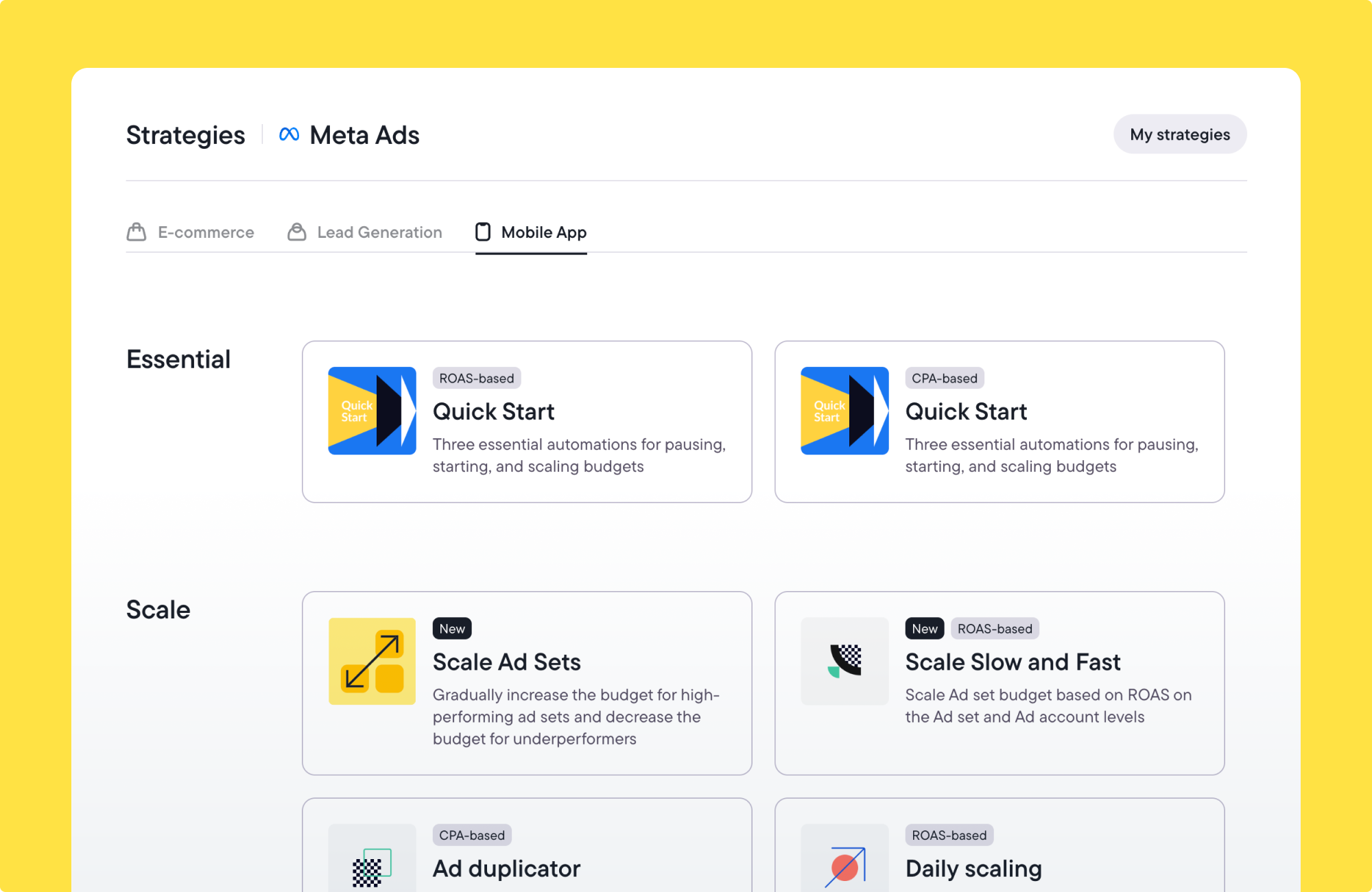
While Meta value rules guide optimization within the platform, Bïrch expands those benefits across your entire ad ecosystem. With Rules, you can automate actions like pausing, scaling, or adjusting budgets the moment performance changes. And with the Ads Launcher, you can launch, validate, and tag campaigns in bulk—turning complex creative workflows into structured, repeatable systems.
Together, these tools help you move from reactive optimization to proactive performance management—closing the gap between strategy, automation, and execution.
FAQs
If you’ve been running Meta campaigns for a while, you’ve probably noticed a small but impactful update in how the platform talks about optimization.
Meta has reintroduced one of its most useful tools, value rules—and it’s no longer just a niche feature for e-commerce. This feature, once called conversion value rules, has evolved into something much more powerful.
Value rules let you tell the system that certain customer segments are more valuable than others, giving you more control over how Meta optimizes and allocates your budget.
It bridges the gap between automation and human insight, allowing you to “train” Meta’s AI to favor the audiences, locations, or devices that matter most.
In this guide, we’ll break down how value rules work, what’s new this year, and how you can use them to guide Meta’s delivery system toward quality, not just quantity.
Key takeaways:
- Meta value rules are no longer limited to e-commerce. They now cover all campaign goals, such as awareness, traffic, leads, and engagement.
- You can now create up to 6 different rule sets within the same account, as well as test seasonal, regional, and strategy-based bid adjustments.
- To analyze whether high-value segments truly drive higher ROAS and LTV, you can track the ad’s performance in Ads Manager’s Breakdown and validate with tools like Google Analytics or your CRM.
- Automation platforms make it simpler to build workflows that connect insights with real-time optimization across campaigns.
- Bïrch automates what Meta value rules start, helping you control ads automatically when performance changes.
What are Meta value rules, and why do they matter?
Originally launched as conversion value rules for e-commerce purchase events, the feature was renamed value rules in 2025 to reflect its broader use across all campaign types and objectives—from awareness and engagement to lead generation and sales.
Value rules let you adjust how much Meta’s algorithm values specific audience segments, based on the return they bring for your business.
In other words, instead of optimizing for the lowest-cost conversions, you can use value rules to tell Meta which conversions are most valuable to you based on audience, placement, and conversion criteria.
According to Investing, in 2022, Facebook ads reached 34.1% of the global population aged 13+. That’s about 2.11 billion people. Such massive reach is powerful, but it also means advertisers risk spreading budgets thin. Value rules help you spend where it actually matters: on high-value, high-intent users.

You can assign positive or negative adjustments for these criteria, so your budget focuses on the audiences that are most likely to deliver stronger, long-term results.
Let’s say you own an online clothing store, and you’re running ads to drive traffic. Meta will automatically optimize for the cheapest purchases, even though your insights tell you that women aged 25–34 tend to spend more and are more likely to become regular clients.
With value rules, you’re telling Meta, “Bid more for that audience.” It’s up to you how much more you can increase the bid. For example, you can set the bid to be +20% for women in that age group, and even decrease the bids for audiences who tend to browse without buying.
The logic is simple: instead of treating all conversions equally, you have the power to weight them based on quality.
Why value rules are essential for optimizing conversions and lifetime value
Not all conversions are of equal value. Some customers buy once and disappear, while others return, subscribe, or spend more over time. Value rules tell Meta’s algorithm which actions and users are truly worth investing in.
Instead of spreading budget evenly across lower-value audiences, you can drive more conversions from people with high intent. This improves ROAS and LTV, two of the most important metrics for long-term profitability.
For example, if data shows that leads from Germany convert at a higher rate, value rules let you bid more for those users by choosing that location.

Applying the same logic, if engagement from certain places (like Instagram stories) generates better downstream sales than others (like Facebook stories), you know you should prioritize spend there.
How Meta’s AI uses value rules for smarter delivery
Meta’s ad delivery system is built around ad auctions and machine learning. It constantly analyzes audience behavior, conversion data, and creative performance to decide where spend will have the most impact.
Value rules now take smart delivery further.
When you define a rule, Meta’s AI still handles real-time optimization. The difference is that it now considers your chosen “value priorities” in its decision-making process. So instead of treating every conversion equally and choosing the users who see your ads, Meta now uses your set rules to adjust bid intensity within the auction, prioritizing impressions that are likely to drive better results.
In short, you provide the logic, and Meta applies it at scale.
Over time, this creates a learning loop. The system learns which audiences are worth more, and your value rules help it act on that insight instantly.
What’s new in 2025: expanded features and availability
2025 marks the biggest update yet to Meta’s value rules since their initial release. Here’s what’s new:
1. Value rules across all objectives
Once limited to “sales” and “app promotion” objectives, value rules are now available for all major objectives. This means you can assign value adjustments throughout the entire customer journey, not just at the bottom of the funnel.
2. Multiple rule sets (up to six per account)
You can now create and manage up to six different rule sets per account. This allows you to:
- Manage multiple business lines within a single ad account
- Test different bid adjustment strategies (+10%, +20%, etc.) to see which one works best for you
- Experiment with seasonal versus evergreen rule sets at the same time, without them interfering with one another

3. Location-level value expression: city-specific bidding
You can assign city-level adjustments if you see strong performance variations by market, increasing or decreasing your ad bids for specific cities.
4. Placement-level value rules (feed, reels, stories, audience network)
Meta has extended value rules to work at the placement level, meaning you can set unique bid adjustments for specific placements across Facebook and Instagram feed, reels, stories, and audience network.

5. Attaching and detaching rule sets mid-flight without resetting learning
A game-changer for 2025 is the ability to attach or detach value rule sets while campaigns are live, without resetting the learning phase. This means you can update priorities, swap seasonal strategies, or test new multipliers in real time, all without disrupting performance optimization.
6. Marketing API access and advanced integrations
For larger teams and automation rules, Value Rules are now available through the Marketing API, allowing direct integration with third-party tools for real-time monitoring and performance automation.
7. Key differences between value rules and bid multipliers
While both tools modify bid behavior, bid multipliers only decrease bids and have no reporting layer.
Value rules allow increases and decreases, include built-in reporting breakdowns, and are accessible directly from Ads Manager.
Strategic use cases: maximizing customer lifetime value with value rules
Value rules let you align Meta’s delivery system with your business’s long-term goals. Using them strategically helps you prioritize audiences that bring the most revenue.
The link between value rules and long-term profitability
Meta’s AI naturally optimizes for volume: more conversions, installs, and engagement. You can redirect spend toward high-LTV segments—the customers who keep buying, subscribing, or referring others—by layering multiple value rules across audience, location, and device.
Let’s look at Aerie as an example. The women’s lifestyle brand identified 50 designated market areas where brand awareness was low. They used value rules to give them a boost by increasing bidding.

The results speak for themselves:
- 4.9-point lift in ad recall
- 5.6-point lift in brand favorability
- 22% lower cost per ad recall lift
- 33% lower cost per brand favorability lift
- 72% higher reached recall
By strategically raising bids in markets with strong growth potential, Aerie has invested in audiences who are more likely to convert and stay loyal over time. The approach helps build brand equity in high-value regions, translating into stronger long-term profitability through repeat purchases and sustained customer relationships.
Identifying and prioritizing high-value customer segments
Before creating any value rules, check which customer groups drive the highest revenue or engagement.
Notice patterns in:
- Demographics (age, gender, city/country)
- Device type or OS (Android versus IOS)
- Engagement source (reels, story, feed)
- Behavioral data (repeat purchases, subscription renewals, website revisits, etc.)
Build your value rules around these insights—for example, “+30% for top-tier markets, −20% for regions with low purchase completion rates.”
We spoke with Baruch Labunski, CEO at Rank Secure, who shared how he uses value rules to prioritize long-term value.
Applying LTV data to guide bid adjustments
You can turn LTV data into bidding logic with Meta value rules. Here’s how:
- Use higher bid multipliers for audiences that historically deliver higher LTV.
- Combine this with custom conversions (like “repeat buyer”) to guide AI toward better-quality conversions.
- Adjust seasonally—for example, increase bids in months when returning customers spike.
When I make the decision to increase or decrease my bids, I value the data around customer value over time. If an audience has been high-value, highly loyal, and high-retention over time, I would be more comfortable increasing my bid, even if the cost of the lead initially seems high. On the other end, if the leads are cheap but won’t close, we will likely spend less on them and most likely stop sending leads after a short time.
How to set up your first Meta value rule (step-by-step)
Setting up value rules in Meta Ads Manager is simple once you define who your most valuable customers are and how much more you’re willing to bid for them.
Step 1: check prerequisites
Before creating your first rule, make sure you:
- Have conversion tracking properly set up in Meta Ads Manager (via pixel, API, or SDK).
- Set a campaign objective that supports value rules (sales, leads, app promotion, awareness, traffic, or engagement).
- Have a Business Account with admin access.
Step 2: go to advertising settings

Open Meta Ads Manager → advertising settings → value rules (you’ll find it near the top section of your business settings).

Click value rules, and it will take you to another tab where you can create up to six rule sets per account.
Step 3: define your preferred audience

Choose up to two conditions that describe your high- or low-value audience. You can use parameters such as age, gender, location, and device.
For example: “Increase bid by 50% for women aged 25–34.”

Step 4: set bid adjustments
Next, decide how you want to modify your bid:
- Increase bids (up to +1,000%) to capture high-value audiences.
- Decrease bids (up to −90%) to reduce spend on lower-value segments.
Step 5: prioritize rules within a set
For audiences that meet multiple rule conditions, Meta prioritizes rules, selecting only the first matching rule in the list. For this reason, be sure to prioritize rules based on their relevance to your goals.
Step 6: apply and monitor
Once your rule set is ready, you can attach it to eligible campaigns during setup. Simply choose “use value rules” under your campaign’s performance goal.
From there, monitor results in Ads Manager → Breakdowns → value rules. You’ll see how each role influences outcomes like conversions, cost per result, and ROAS.
Integrating value rules with Advantage+ shopping campaigns
If you’re running Advantage+ sales campaigns or Advantage+ app campaigns, you can now layer value rules without disrupting Meta’s machine learning. The system keeps optimizing for conversions while incorporating your bid logic in real time.
Advanced optimization tactics
Placement-specific bidding: feeds vs stories vs reels
Placement impacts performance, and value rules now let you reflect that directly in your bidding strategy.
If Instagram Reels perform stronger than Facebook Stories, you can apply a positive adjustment to Reels and reduce bids to Stories without having to create a new campaign.
Device-level adjustments: mobile vs desktop optimization
Performance may vary by device type. With value rules, you can bid higher for users based on the mobile operating system, IOS or Android, depending on where you see better conversion rates or purchase behavior.

Geo-targeting with value rules: regional and city-level differences
Not all markets deliver equal results, and Meta lets you reflect those differences precisely in your optimization. You can set higher bids for high-performing cities or regions, and reduce bids where ROI is weaker.
This is also useful when you want to run seasonal campaigns—for example, by increasing bids in tourist-heavy areas during peak travel months and reducing spend where demand drops.
Improving lead quality in sales and lead generation campaigns
For lead generation campaigns, Meta value rules are a powerful way to filter out low-quality leads before they consume your budget.
For example, you can lower bids for users below a certain age range or outside target locations. Or, you can increase bids for devices or placements that historically bring higher conversion-to-sales ratios.
Dynamic segmentation: adapting rules to evolving customer behavior
Consumer behavior changes fast, and Meta’s AI learns continuously. You can constantly revisit and adjust your value rules based on real performance data.
If a placement that once underperformed suddenly starts driving conversions, you can always update your bid logic instead of removing it. Likewise, you can reduce bids for segments showing fatigue or rising CPAs.
Measuring and proving success
Setting up value rules is just the start. The real impact comes from tracking how they influence campaign performance over time.
Key metrics to track, and questions to ask
When value rules are active, monitor metrics that show both short- and long-term impact, including:
- ROAS: Are higher-value segments generating more revenue per dollar spent?
- CPA: Is your cost rising but delivering better-quality conversions?
- LTV: Are your campaigns capturing customers who spend or engage more over time?
- CTR and conversion rate: Are optimized segments producing stronger engagement signals?
You can use Bïrch to translate value rule logic into real-time actions (pause, scale, rotate) whenever KPIs cross a threshold, without having to monitor everything manually.

Conversion tracking and reporting in Meta Ads Manager
Analyze value rules directly in Ads Manager using the breakdown menu:
- Ads Manager → columns → customize columns → value rules to see performance per rule
- The breakdown → value rule set options let you view conversions, CPA, and ROAS by rule category (e.g., age, device, region)
Compare results over different time ranges to identify consistency, and see whether you need to adjust the bid.
Attribution modeling: understanding how value rules impact the funnel
Value rules influence where Meta’s AI spends money, not necessarily who converts first.
- To isolate the impact, use attribution breakdowns to compare results before and after activating value rules.
- Track whether improved LTV and retention correlate with the adjusted audiences.
- Complement Meta’s reporting with first-party data (CRM, Shopify, Google Analytics) for a complete view of long-term value.
Using third-party analytics for cross-validation
While Meta’s in-platform data is valuable for campaign monitoring, it doesn’t always tell the full story, especially when measuring LTV or cross-channel behavior. That’s where third-party analytics tools come in.
You can connect data from platforms like Google Analytics, AppsFlyer, Wicked Reports, or Hyros to see and verify how value rules affect long-term ROI.
These tools give you insight into whether the audiences you prioritized with value rules continue delivering value beyond the initial conversion.
For example, if Meta reports a higher ROAS from users in specific cities, but your CRM data shows lower repeat purchase rates there, you can refine your value rules to rebalance bids toward truly profitable regions.
Troubleshooting and avoiding common pitfalls
Even with Meta’s expanded 2025 update, value rules can be tricky to implement correctly. Many advertisers set them up once and forget about them, or apply rules that unintentionally hurt performance.

Here are some of the most common issues and how to avoid them:
1. Overcomplicating your rule sets
Just because you can create six rule sets doesn’t mean you should. Too many overlapping conditions can confuse Meta’s delivery system, especially if multiple rules compete for the same audience.
Instead, start small by testing one or two simple adjustments (e.g., +20% for iOS users in high-performing regions). You can always expand when you see clear data-backed improvement.
2. Misaligned objectives
Applying purchase-related bid logic to a traffic or awareness campaign can lead to misallocated spend and misleading metrics. Always match your rule intent with your campaign objective, e.g., higher bids for high-engagement placements in awareness campaigns, or value-weighted bids by location in sales campaigns.
3. Ignoring real performance data without validation
If you assume a segment is high-value without checking post-purchase or CRM data, Meta will optimize toward that assumption, even if it’s wrong.
Review rule performance weekly. Compare Ads Manager results with third-party analytics or LTV data to confirm that high-value segments stay profitable over time.
4. Forgetting to reorder rules
Meta applies the first matching rule in each set. If your most important rule is buried under others, it may never trigger—so keep your most impactful or high-value logic at the top.
5. Resetting or rebuilding too often
Editing rule sets frequently can cause instability and delay optimization.
Although 2025 updates prevent learning resets when detaching or reattaching rules, completely recreating them still restarts the process. Small tweaks are better than deleting and rebuilding full rule sets.
The smart advertiser’s 2026 playbook
If there’s one thing to take away from Meta value rules, it’s that Meta is finally giving you more control within automation. You can now tell the algorithm what your business cares about, and then let it work its magic.
Here are the key benefits we’re seeing so far:
- You play a role in how the ad system works by prioritizing audiences to drive profit instead of just getting clicks. You can control where, when, and to whom Meta shows your ads.
- Value rules are available for all major objectives.
- You can set different rule values and run broader campaigns all in one place, without needing to separate ad sets.
- You can set up to six rule sets for different goals or seasons.
- Meta’s delivery aligns with your internal business logic. You “feed” the system the information it needs to produce the best results for your business.
Your quick-start checklist
- Set up value rules in advertising settings in your Meta Ads account.
- Define criteria that reflect your most valuable segments: age, city, placement, or device.
- Apply percentage adjustments that reward top-performing audiences (increases or decreases).
- Attach rules to live campaigns and let them run for at least one full learning cycle.
- Measure performance using the breakdown → by value rules report in Ads Manager.
- Optimize and iterate. Adjust bid multipliers, test seasonal rules, and compare results over time to see performance.
Taking value-based optimization further with automation
Machine learning now processes millions of signals in real time—but even the smartest algorithm needs direction.

While Meta value rules guide optimization within the platform, Bïrch expands those benefits across your entire ad ecosystem. With Rules, you can automate actions like pausing, scaling, or adjusting budgets the moment performance changes. And with the Ads Launcher, you can launch, validate, and tag campaigns in bulk—turning complex creative workflows into structured, repeatable systems.
Together, these tools help you move from reactive optimization to proactive performance management—closing the gap between strategy, automation, and execution.
FAQs

Meta value rules are features that let you tell Meta’s ad system how much audiences, devices, or placements are worth to your business. You can use them to guide Meta’s AI toward outcomes that bring higher value—not just conversions.

First, you define which rule parameters are most valuable to you and whether you want to increase or decrease the bid (for example, you can set rules like: “+20% for IOS users in Germany,” depending on your goals), and Meta’s system will automatically adjust bids within the selected parameters.

You’ll find value rules inside Meta Ads Manager, under advertising settings → value rules. You’ll get the option to create rule sets (you can create up to six rule sets per account).

Bid multipliers only let you reduce bids and don’t come with dedicated reporting. Meta value rules support both increases and decreases in values—plus you can monitor the reports in Ads Manager.

Yes. Go to Ads Manager → breakdown → by value rules to see how each rule affects performance metrics and conversions. This way, you can see which adjustments are actually bringing results and which might need to be changed for better performance.

While any advertiser who wants more control over their campaigns can use Meta value rules, it’s especially useful for those running multi-market, multi-device, or high-LTV campaigns.

Revealbot has a new look and a new name—we’re now Bïrch! The change highlights our focus on bringing together the best of automation and creative teamwork.










